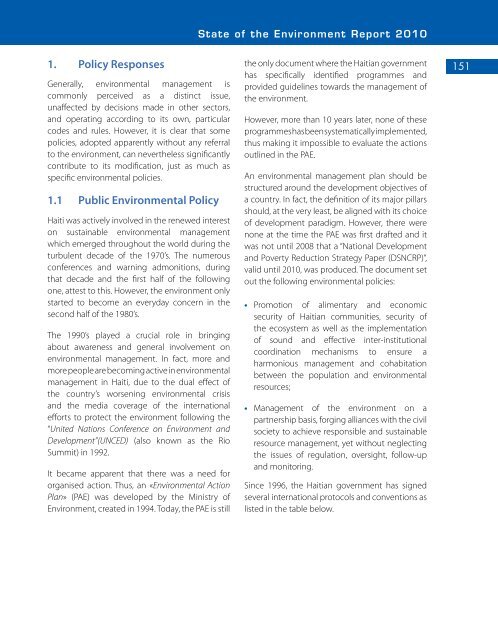GEO Haiti 2010
GEO Haiti 2010
GEO Haiti 2010
You also want an ePaper? Increase the reach of your titles
YUMPU automatically turns print PDFs into web optimized ePapers that Google loves.
State of the Environment Report <strong>2010</strong><br />
1. Policy Responses<br />
Generally, environmental management is<br />
commonly perceived as a distinct issue,<br />
unaffected by decisions made in other sectors,<br />
and operating according to its own, particular<br />
codes and rules. However, it is clear that some<br />
policies, adopted apparently without any referral<br />
to the environment, can nevertheless significantly<br />
contribute to its modification, just as much as<br />
specific environmental policies.<br />
1.1 Public Environmental Policy<br />
<strong>Haiti</strong> was actively involved in the renewed interest<br />
on sustainable environmental management<br />
which emerged throughout the world during the<br />
turbulent decade of the 1970’s. The numerous<br />
conferences and warning admonitions, during<br />
that decade and the first half of the following<br />
one, attest to this. However, the environment only<br />
started to become an everyday concern in the<br />
second half of the 1980’s.<br />
The 1990’s played a crucial role in bringing<br />
about awareness and general involvement on<br />
environmental management. In fact, more and<br />
more people are becoming active in environmental<br />
management in <strong>Haiti</strong>, due to the dual effect of<br />
the country’s worsening environmental crisis<br />
and the media coverage of the international<br />
efforts to protect the environment following the<br />
“United Nations Conference on Environment and<br />
Development”(UNCED) (also known as the Rio<br />
Summit) in 1992.<br />
It became apparent that there was a need for<br />
organised action. Thus, an «Environmental Action<br />
Plan» (PAE) was developed by the Ministry of<br />
Environment, created in 1994. Today, the PAE is still<br />
the only document where the <strong>Haiti</strong>an government<br />
has specifically identified programmes and<br />
provided guidelines towards the management of<br />
the environment.<br />
However, more than 10 years later, none of these<br />
programmes has been systematically implemented,<br />
thus making it impossible to evaluate the actions<br />
outlined in the PAE.<br />
An environmental management plan should be<br />
structured around the development objectives of<br />
a country. In fact, the definition of its major pillars<br />
should, at the very least, be aligned with its choice<br />
of development paradigm. However, there were<br />
none at the time the PAE was first drafted and it<br />
was not until 2008 that a “National Development<br />
and Poverty Reduction Strategy Paper (DSNCRP)”,<br />
valid until <strong>2010</strong>, was produced. The document set<br />
out the following environmental policies:<br />
• Promotion of alimentary and economic<br />
security of <strong>Haiti</strong>an communities, security of<br />
the ecosystem as well as the implementation<br />
of sound and effective inter-institutional<br />
coordination mechanisms to ensure a<br />
harmonious management and cohabitation<br />
between the population and environmental<br />
resources;<br />
• Management of the environment on a<br />
partnership basis, forging alliances with the civil<br />
society to achieve responsible and sustainable<br />
resource management, yet without neglecting<br />
the issues of regulation, oversight, follow-up<br />
and monitoring.<br />
Since 1996, the <strong>Haiti</strong>an government has signed<br />
several international protocols and conventions as<br />
listed in the table below.<br />
151

















